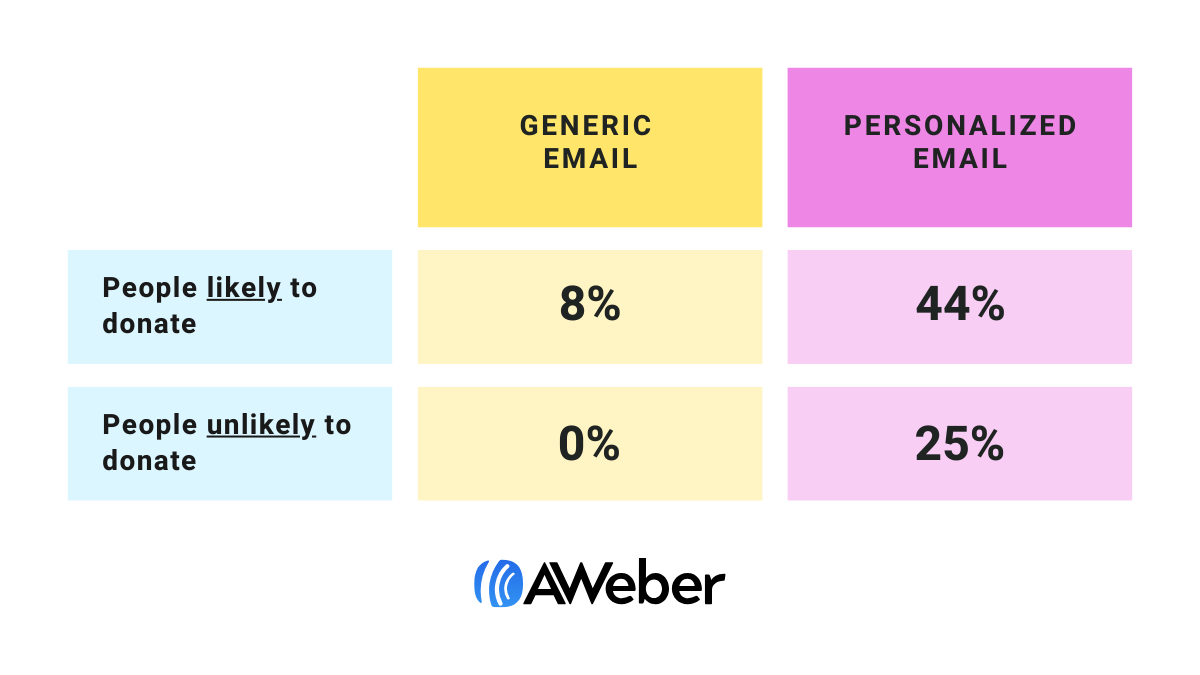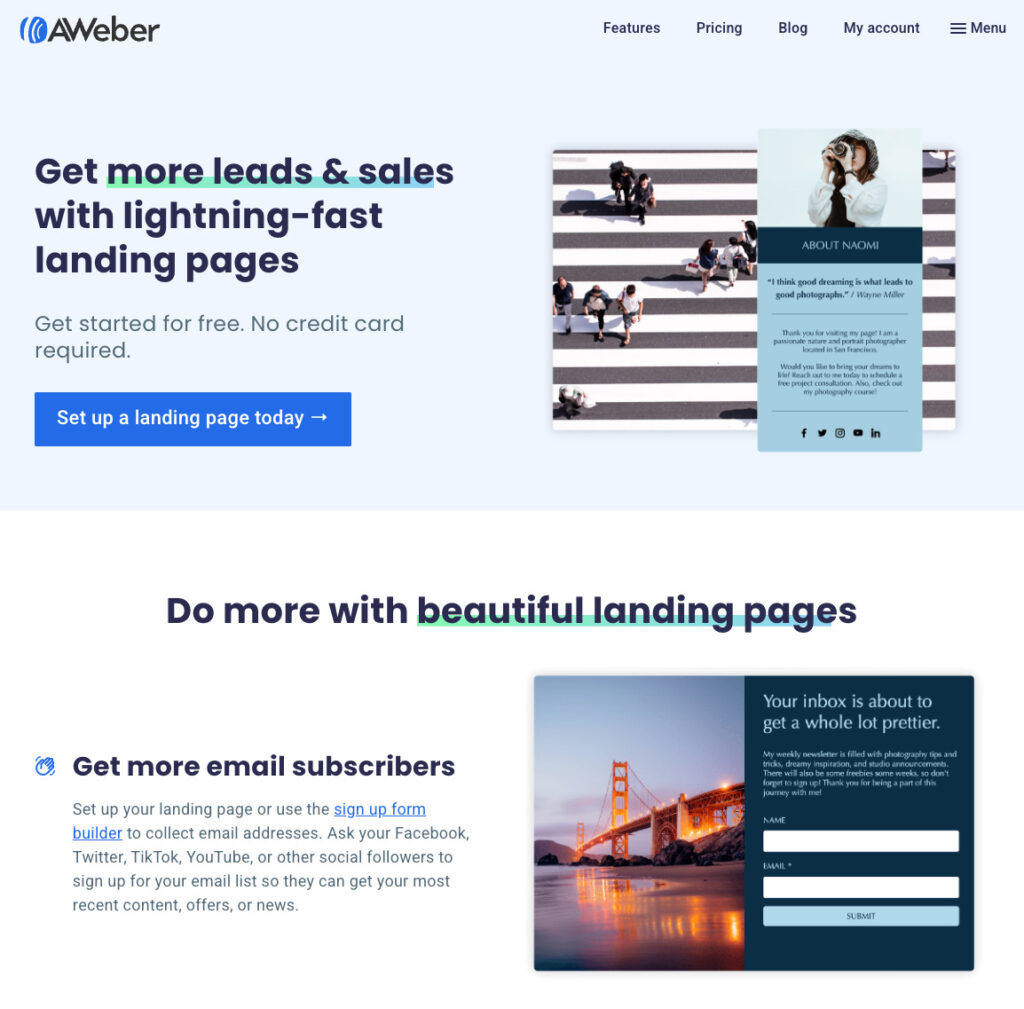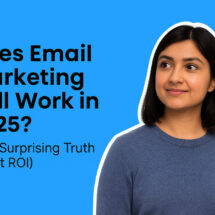Email personalization: Using dynamic content to speak to your audience
By Sean Tinney August 21, 2024
Daniel Pink tells a story in his book “Drive” about a university struggling to collect donations for a food drive. Researchers had the notion that adding context to make the ask feel more for an individual, and not just blanket marketing, they’d see a better response.
So they decided to run a test with their outreach emails. They split tested two versions of their message:
- Half of the students got a generic email about the food drive.
- The other half got a personally addressed message with details about their closest donation drop offs. They also got a followup call.
What happened (you can probably guess)?
Donations went up. Way up.
Before the test, researchers evaluated whether students had a high, or low likelihood of donating. The personalized emails saw an increase from folks who were likely to donate and even greater growth in the group of people who they were assuming wouldn’t donate.

Yes, you’re reading that right. The personalized, contextually relevant email got more donations from people researchers weren’t expecting to donate than the generic email got from the most likely donors.
Personalization works. Let’s talk about how to do it right.
Personalization is more than just a name
When people talk about personalization in email, the example they give is often
“Hi [FIRST NAME],”
That’s a good start and if you do nothing else do that because it’s so easy.
But don’t stop there. There’s so much more you can do with simple personalization.
- Reference the site or community they signed up from in your welcome message if you’re working with partners to build your audience.
- Include information that is relevant to someone’s location, like nearby stores or news that is relevant to different regions.
- Send people similar content to what they’ve clicked through to in the past(you can tag people based on the links they click in broadcasts and automated campaigns).
- Recommend products based on what they’ve purchased in the past.
- Ask people their goals or interests when they sign up. Then reference those goals or interests in welcome series and newsletters.
Benefits of email personalization
By personalizing your emails so they solve your subscribers’ unique problems, you provide immediate value. And the sooner you can do that, the sooner your subscribers will understand what you bring to the table.
Increased engagement
Personalized emails are more likely to be opened and read. By addressing the specific interests and needs of your subscribers, you can craft messages that capture their attention and prompt them to take action. This leads to higher open rates, click-through rates, and overall engagement with your content.
Higher conversion rates
When your emails provide relevant value to your subscribers, they’re more likely to convert into customers. Personalized offers, product recommendations, and targeted content can dramatically increase the chances of a sale. According to research, 80% of consumers are more likely to make a purchase when the offer is personalized to them.
Improved customer retention
Personalization helps in building stronger relationships with your customers. By consistently delivering relevant content, you can keep your audience engaged and interested in what you have to offer. This leads to higher customer satisfaction and loyalty, reducing churn rates and increasing lifetime value.
Better customer experience
Personalized emails enhance the overall customer experience. When subscribers receive emails that are tailored to their preferences and behaviors, they feel valued and understood. This positive experience can set your brand apart from the competition and foster long-term loyalty.
Enhanced brand perception
By showing that you understand and care about your subscribers, you can improve the perception of your brand. Personalized emails demonstrate that you are attentive to their needs and preferences, which can lead to a stronger emotional connection with your audience.First, let’s talk about why you should be personalizing your email marketing efforts.
Where to gather information for personalization
Just like any relationship, the best ones are established when you get to know one another. As you learn more about the people signing up to your email list, you can target them with the right kind of content to build your relationship.
To help you personalize your emails for your audience and start seeing stronger results, let’s take a look at how you can gather the information you need to begin personalizing.
On your sign up form
To effectively personalize your emails, you need to collect information about your subscribers. Since your sign up form is often the first step a subscriber takes before joining your email list, it’s a great opportunity to get started.
If you want to send targeted emails that include a subscriber’s first name, confirm you’re collecting first names in the sign up form. Or adjust your form to include a first name field, like this sign up form for Fable & Folly’s podcast updates.

In addition to asking for name and email, you can include custom fields that require subscribers to provide more information about themselves, such as the city where they live or type of content they prefer.
Try to avoid asking for too much information up front. Including too many fields can be overwhelming for your potential subscribers. Don’t create a barrier that could prevent them from joining your list.
If you do include more than just name and email address, emphasize the value of your emails. Explain what kind of targeted content they can expect.
Here’s an example:
Let’s say you write content for a diet food blog and you want to send targeted content based on a subscriber’s dietary needs. Setting up a form with selections for the type of diet they’re most interested in will make it much easier to identify and send relevant information to your subscribers.

Through a customer survey
If you need information about your subscribers that are already on your list, you can try to gather that information through a survey.
But keep in mind that on average only 30% of your subscribers will respond to your survey. So while a survey is a great way to learn more about your audience, everyone on your list won’t respond so keep your expectations in check.

However, when you reach out to your customers directly, you not only get valuable feedback in return, you also show them you care about how they are doing.
As you hear from your audience, you can use your survey insight as you craft your next emails.

Interactions with your emails
You can add a tag when a subscriber clicks a link in your email to more easily categorize them into groups (or segments).
For example, at the bottom of AWeber’s weekly newsletter, we include our most recent blog posts. Based on what someone clicks, I learn what they’re interested in.
Now I create email content specifically for that segment of customers. In the example below one group may want more content on artificial intelligence, another on optimizing subject lines, and the third on growing their email list.

Interactions with your website
Use the pages visited or links clicked on your website to gauge what they may be interested in.
To be able to properly track page visits a cookie is required. To receive this cookie, a subscriber will need to first visit the website through a link in the email. Once a subscriber has received this cookie, an email provider can track a page visit regardless of where a subscriber came from.
To allow tracking of your customer’s interactions on your website, you’ll need to add a piece of code to your site.
For example, if a subscriber visited our landing page builder page, we can start sending targeted messages to them talking about the benefits of using our platform for creating their landing pages.

Purchase behavior
Using purchase behavior data to personalize your emails allows you to tailor your messaging and offers to individual customers based on their previous buying habits. You can use this to create targeted campaigns that will increase the likelihood of repeat purchases and foster loyalty.
Personalization based on purchase behavior data can also help you cross-sell or upsell related products or services to customers who have shown interest in similar items.
Here’s an example from Fanatics. Based on my purchase history, they’ve segmented me as an “Philadelphia Eagles” fan. In this email they most likely used dynamic content to change the image to show fans in Eagles gear. A New York Giants fan would receive an email reflecting their favorite team.

What to personalize in your emails
Once you’re collecting the right data, there’s one rule to keep in mind: With great personalization power comes great responsibility.
Personalized email content should feel natural and not forced. It’s so much more than including a first name in a subject line or salutation.
When you show your subscribers that you understand their needs, desires, fears, preferences and other aspects of their personality, it will lead to an increase in conversions. And more importantly, a more loyal customer..
Truly personal emails look at things like:
- Which emails someone has opened and clicked through from in the past
- Where on your site they visit
- How they originally found you and what inspired him/her to sign up to your list
- Products or services they’ve purchased in the past
- Location or demographic information
- Or other criteria that you collect from your subscribers
By personalizing your emails so they solve your subscribers’ unique problems or give them content related to their specific interests, you’re able to immediately provide value. And the sooner you can do that, the sooner your subscribers will understand how important your emails are.
Here are some examples of using personalization emails to delight your subscribers.
Set expectations early
Your welcome message is your first opportunity to do this. In your welcome message, establish yourself as an expert in the field. Make sure to provide original content on a topic you know subscribers are interested in and they’ll be more likely to trust you when they’re ready to make a purchase.
Here’s a great example of a targeted, personalized welcome email from WeddingWire, a go-to resource for everything wedding related, which subscribers receive immediately after signing up for an account:

In the sign up form, visitors are asked to provide their expected wedding date. With that information, WeddingWire knows to send content related to where you are in the wedding process.
They use this message to congratulate you on your engagement and go the extra step to clarify what you’re likely to receive in the future. The checklist is also the perfect resource for couples during the early planning process.
As the wedding date gets closer, WeddingWire sends content based on other checklist tasks the engaged couple should be completing, such as choosing attire, picking out invitations and more.
By continuing to send content to your subscribers throughout your relationship with them, you can increase awareness of what you have to offer, show you care and keep your brand top of mind.
Celebrate milestones
Another great way to show you care is by celebrating the big milestones together. It can be as simple as a birthday message to let your customers know you’re thinking about them. Facebook does a great job of this in their birthday celebration emails, like the one below:
They provide a quick and simple email that is totally contextual, and the goal is just to make you smile.
You can celebrate important business milestones as well. Kickstarter’s congratulatory emails are a delightful example of how they celebrate their users’ successes. Check out the message you receive when you hit 100 backers:

While these are only a few examples of how you can send personalized emails, consider how you might be able to do the same for your own audience.
Geography
Personalizing emails based on your subscribers’ geographical location is another great way to provide value to specific segments of your email list. If you’re running an event in their area, or want to reach out and let people know that your nearby store is open, you can collect their geographical information through your forms directly.
Your turn
Email personalization is a powerful tool that can significantly enhance your email marketing efforts. By understanding your subscribers’ preferences, behaviors, and needs, you can create tailored content that resonates with them and drives engagement. From increasing open rates and conversions to improving customer retention and satisfaction, the benefits of personalized emails are clear.
As you gather more data and refine your personalization strategy, you’ll build deeper connections with your audience and foster long-term loyalty. Start personalizing your emails today and experience the positive impact on your business.
Already personalizing your emails? Share your successes in the comments!
 87% off ends soon!
87% off ends soon! 
